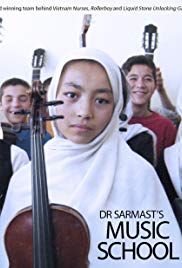1. Show students The Bolero using appropriate discussion questions and activities from the Learning Guide to that film. There is no need for the viewing of The Bolero to be close in time to the presentation of Dr. Sarmast’s Music School. Do not tell students that The Bolero relates in any manner to Dr. Sarmast’s Music School. If the class is already familiar with Bolero this step can be skipped.
2. Show students the location and size of Afghanistan on a map or a globe. Provide them with a brief description of the recent history of the country and the censorship of music within Afghanistan (see Helpful Background section above) and/or have the presentations described in Preparation Step #5.
3. Show students the two film clips from the movie.
4. Show students fifteen minutes of the film clip from the performance by the school at the Kennedy Center for the Performing Arts in Washington, D.C. on February 7, 2013, starting at minute 11.5.
5. Lead a class discussion using some of the discussion questions suggested below.
6. Follow up with appropriate assignments.
Discussion Questions
1. Is access to music and freedom of musical expression a basic human right, like the freedom to express an opinion, the freedom to chose work and a profession?
Suggested Response:
The discussion should include a reference to Article 27 of the Universal Declaration of Human Rights:
(1) Everyone has the right freely to participate in the cultural life of the community, to enjoy the arts and to share in scientific advancement and its benefits.
(2) Everyone has the right to the protection of the moral and material interests resulting from any scientific, literary or artistic production of which he is the author.
2. What would your life be like without music?
Suggested Response:
There is no one correct answer to this question.
3. One of the persons shown in the film states, “Music is a pure thing that helps you reach God.” Do you agree or disagree? Explain why?
Suggested Response:
There is no one correct answer to this question. A strong answer will mention: (1) the strong feelings that music evokes; (2) its timeless quality; (3) its capacity to remove one from the cares of daily life; (4) its universal quality (most everyone can understand the emotions evoked by music).
4. One of the people shown in the film states, “When speech ends, music begins” Please explain what he meant.
Suggested Response:
There is no one correct answer to this question. A strong answer will refer to the universal power of music to communicate feelings.
5. What would your life be without dramatic presentations as we can see in movies, on television, and on the stage?
Suggested Response:
There is no one correct answer to this question.
6. ANIM receives significant support from foreign donors, but some money comes from the Afghan government. Do you think it’s a good idea in a society that is as poor as Afghanistan and which is engaged in a war with foes like the Taliban to spend money on arts education?
Suggested Response:
There is no one correct answer to this question.
7. One of the people shown in the film states, “Religion is not something that should separate us.” Please explain what he meant.
Suggested Response:
There is no one correct answer to this question. A strong answer will refer to the fact that people should look for those beliefs that they have in common, not those that are different.
8. The American violin teacher says that he believes that it is the responsibility of Americans to come and help rebuild Afghanistan. Do you agree or disagree? Explain your position.
Suggested Response:
There is no one correct answer to this question.
9. Does watching this film change your perception of the role of the United States and the other allied countries contributing troops to the NATO effort in Afghanistan?
Suggested Response:
There is no one correct answer to this question, but it is clear that the liberation of a country which was deprived of the human right to play and listen to music, and whose musical culture was being strangled by adherents of a fundamentalist ideology is a good thing. Whether it is worth tens of thousands of lives, tens of thousands of injured and maimed people, and the expenditure of billions upon billions of dollars is a different and more complicated question. But then again, the main reason for NATO involvement in the Afghan civil war was not primarily or even partially an effort to support freedom of artistic expression.
Assignments
Any of the discussion questions can serve as essay prompts. Additional assignments are set out below:
1. Dr. Sarmast says that “Bach, Beethoven, Mozart are universal and do not belong only to the West.” Find a piece of music from another culture that you believe is so good as to be universal. [Teachers should consider allowing students several months to do the research on this assignment. Students should bring five to ten-minute excerpts of the music to class and share their selections. A class or two can be set aside to hear them, or they can be played one at a time over a longer period of time.]
2. As a follow-up to this film have students research and present to the class any of the reports described in Preparation step #5 that have not already been given, or presentations any of the following topics:
- Christian and/or Jewish sects throughout history which have restricted music and/or dancing; [These include, for example, the Quakers, the Baptists, and many others]
- Christian and/or Jewish sects throughout history which have restricted the activities of women, including requiring them to wear wigs and headscarves. [These include, for example, modern day ultra-orthodox Jews.]
- The current status of ANIM and Dr. Sarmast;
- The current political and military situation in Afghanistan;
- The view of moderate Islam about music;


